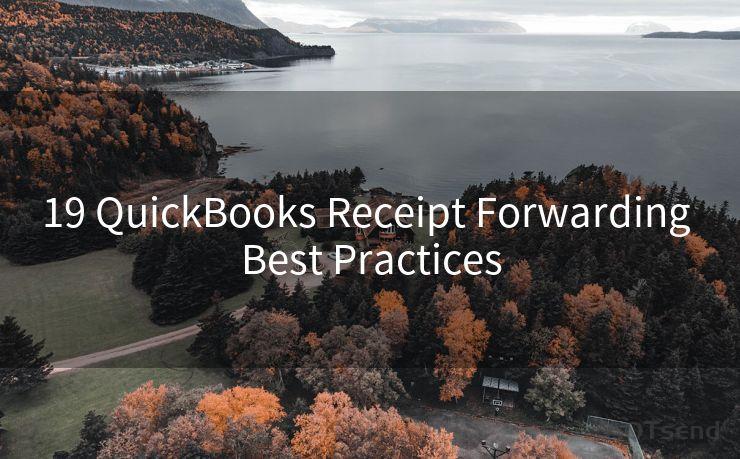19 QuickBooks Receipt Forwarding Best Practices




When it comes to managing finances for your small business, QuickBooks stands out as a powerful tool. Among its many features, receipt forwarding is a crucial aspect that can streamline your bookkeeping process. Here are 19 best practices to help you make the most of QuickBooks receipt forwarding for efficient bookkeeping.
1. Understand Receipt Forwarding
Before implementing any best practices, it's essential to understand what receipt forwarding entails. In simple terms, it involves the automatic forwarding of receipts from various sources to your QuickBooks account, simplifying data entry and record-keeping.
2. Set Up Rules for Forwarding
Establish clear rules for which receipts should be forwarded and which ones can be handled manually. This helps in filtering out unimportant or duplicate receipts.
3. Use Dedicated Email for Receipts
Set up a dedicated email address for receipt forwarding. This ensures that all relevant receipts are sent to a central location, reducing the chances of missing or misplacing them.
4. Integrate with Bank and Credit Card Accounts
Integrate your bank and credit card accounts with QuickBooks. This allows for automatic import of transaction data, including receipts, saving you the trouble of manual data entry.
5. Validate Receipts Before Forwarding
Ensure that all receipts are valid and accurate before forwarding them to QuickBooks. This prevents errors and inconsistencies in your financial records.
6. Standardize Receipt Formats
Standardize the format of your receipts to ensure that QuickBooks can read and interpret them correctly. This includes using a consistent naming convention and file format.
7. Utilize OCR Technology
Make use of Optical Character Recognition (OCR) technology to extract relevant information from receipts automatically. This significantly reduces the time spent on manual data entry.
8. Regularly Review Forwarded Receipts
Regularly review the forwarded receipts in QuickBooks to ensure their accuracy and completeness. This helps identify and rectify any errors promptly.
9. Leverage Mobile Apps
Utilize QuickBooks mobile apps to capture and forward receipts instantly. This is particularly useful for on-the-go businesses that need to track expenses in real-time.
10. Maintain Backups
Maintain regular backups of your QuickBooks data, including forwarded receipts. This ensures data security and easy recovery in case of any unexpected events.
11. Train Your Team
Provide adequate training to your team on the best practices of receipt forwarding in QuickBooks. This ensures smooth and efficient operation across the board.
12. Utilize QuickBooks Support
Take advantage of QuickBooks support team for any queries or issues related to receipt forwarding. They can provide valuable insights and solutions to streamline your process.
13. Optimize Your QuickBooks Settings
Optimize your QuickBooks settings for receipt forwarding. This includes ensuring that the correct accounts and categories are linked for automatic classification of expenses.
14. Monitor and Adjust as Needed
Continuously monitor your receipt forwarding process and make adjustments as needed. This helps in improving efficiency and accuracy over time.
15. Use Additional Tools and Integrations
Explore additional tools and integrations that can enhance your receipt forwarding capabilities in QuickBooks. These could include third-party apps or services that automate specific tasks.
🔔🔔🔔
【AOTsend Email API】:AOTsend is a Managed Email Service for sending transactional emails. Support Email Types: reminders, authentication, confirmations, notifications, verification codes, invoices, password resets, account activations, billing statements, two-factor authentication (2FA), and one-time passwords (OTP) emails, etc. $0.28 per 1000 Emails. 99% Delivery, 98% Inbox Rate.
You might be interested in:
Why did we start the AOTsend project, Brand Story?
What is a Managed Email API, How it Works?
Best 25+ Email Marketing Platforms (Authority,Keywords&Traffic Comparison)
Best 24+ Email Marketing Service (Price, Pros&Cons Comparison)
Email APIs vs SMTP: How they Works, Any Difference?
16. Stay Updated with QuickBooks Updates
Stay updated with the latest QuickBooks updates and enhancements. This ensures that you're making the most of the software's capabilities, including receipt forwarding features.
17. Establish a Clear Audit Trail
Maintain a clear audit trail for all forwarded receipts. This is crucial for compliance and transparency, especially during tax audits or financial reviews.
18. Secure Your Data
Ensure the security of your forwarded receipts by implementing strong encryption and access controls. This protects sensitive financial information from unauthorized access.
19. Continuously Improve Your Process
Finally, continuously strive to improve your receipt forwarding process. Seek feedback from your team, identify bottlenecks, and implement solutions to enhance efficiency and accuracy.
By following these 19 best practices for QuickBooks receipt forwarding, you can streamline your bookkeeping process and ensure accurate financial records for your small business. Remember to adapt and refine these practices as your business grows and evolves.





Scan the QR code to access on your mobile device.
Copyright notice: This article is published by AotSend. Reproduction requires attribution.
Article Link:https://www.mailwot.com/p5731.html



